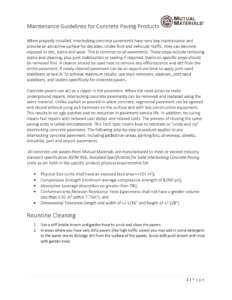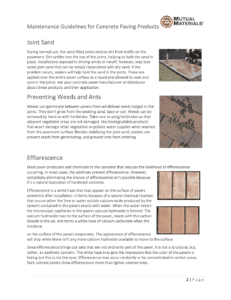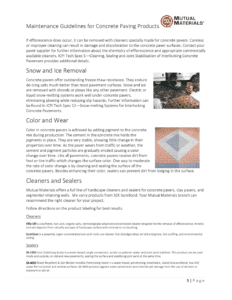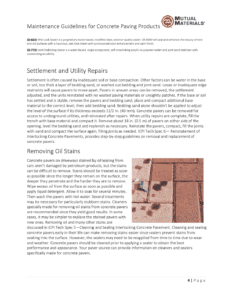When properly installed, interlocking concrete pavements have very low maintenance and provide an attractive surface for decades. Underfoot and vehicular traffic, they can become exposed to dirt, stains and wear. This is common to all pavements. These steps include removing stains and cleaning, plus joint stabilization or sealing if required. Stains on specific areas should be removed first. A cleaner should be used next to remove any efflorescence and dirt from the entire pavement. A newly cleaned pavement can be an opportune time to apply joint sand stabilizers or seal it. To achieve maximum results, use stain removers, cleaners, joint sand stabilizers, and sealers specifically for concrete pavers.
Concrete pavers can act as a zipper in the pavement. When the need arises to make underground repairs, interlocking concrete pavements can be removed and replaced using the same material. Unlike asphalt or poured-in-place concrete, segmental pavement can be opened and closed without using jack hammers on the surface and with less construction equipment. This results in no ugly patches and no reduction in pavement service life. In addition, no curing means fast repairs with reduced user delays and related costs. The process of reusing the same paving units is called reinstatement. This Tech Spec covers how to reinstate or “unzip and zip”
interlocking concrete pavement. The following step-by-step procedure applies to any interlocking concrete pavement, including pedestrian areas, parking lots, driveways, streets, industrial, port and airport pavements.
All concrete unit pavers from Mutual Materials are manufactured to meet or exceed industry standard specification ASTM 936, Standard Specification for Solid Interlocking Concrete Paving Units as set forth in the specific product physical requirements for:
• Physical Size (units shall have an exposed face area <=101 in2);
• Compressive Strength (minimum average compressive strength of 8,000 psi);
• Absorption (average absorption no greater than 5%);
• Conformance to Abrasion Resistance Tests (specimens shall not have a greater volume
loss than 0.92 in3 within 7.75in2); and
• Dimensional Tolerance (length and width of +/-1/16” and height of +/-1/8”).
Routine Cleaning
1. Use a stiff bristle broom and garden hose to scrub and clean the pavers.
2. In areas where you have very dirty pavers (like high traffic zones) you may add in some detergent
to the water mix to dislodge dirt from the surface of the pavers. Scrub with push broom and rinse
with garden hose.
Joint Sand
During normal use, the sand-filled joints receive dirt from traffic on the pavement. Dirt settles into the top of the joints, helping to hold the sand in place. Installations exposed to driving winds or runoff, however, may lose
some joint sand that can be simply replenished with dry sand. If the problem recurs, sealers will help hold the sand in the joints. These are applied over the entire paver surface as a liquid and allowed to soak and cure in the joints. Ask your concrete paver manufacturer or distributor about these products and their application.
Preventing Weeds and Ants
Weeds can germinate between pavers from windblown seeds lodged in the joints. They don’t grow from the bedding sand, base or soil. Weeds can be removed by hand or with herbicides. Take care in using herbicides so that
adjacent vegetated areas are not damaged. Use biodegradable products that won’t damage other vegetation or pollute water supplies when washed from the pavement surface. Besides stabilizing the joint sand, sealers can
prevent seeds from germinating, and prevent ants from entering.
Efflorescence
Most paver producers add chemicals to the concrete that reduces the likelihood of efflorescence occurring. In most cases, the additives prevent efflorescence. However, completely eliminating the chance of efflorescence isn’t possible because it’s a natural byproduct of hardened concrete.
Efflorescence is a white haze that may appear on the surface of pavers sometime after installation. It forms because of a natural chemical reaction that occurs when the lime or water soluble calcium oxide produced by the cement contained in the pavers reacts with water. When the water enters the microscopic capillaries in the pavers calcium hydroxide is formed. The calcium hydroxide rises to the surface of the paver, reacts with the carbon
dioxide in the air, and forms a white haze of calcium carbonate when the moisture on the surface of the pavers evaporates. The appearance of efflorescence will stop when there isn’t any more calcium hydroxide available to move to the surface.
Since efflorescence brings out salts that are not ordinarily part of the paver, it is not a structural, but, rather, an aesthetic concern. The white haze may give the impression that the color of the pavers is
fading but this is not the case. Efflorescence may occur randomly or be concentrated in certain areas.
Dark colored pavers show efflorescence more than lighter-colored ones.
If efflorescence does occur, it can be removed with cleaners specially made for concrete pavers. Careless
or improper cleaning can result in damage and discoloration to the concrete paver surfaces. Contact your
paver supplier for further information about the chemistry of efflorescence and appropriate commercially
available cleaners. ICPI Tech Spec 5—Cleaning, Sealing and Joint Stabilization of Interlocking Concrete
Pavement provides additional details.
Snow and Ice Removal
Concrete pavers offer outstanding freeze-thaw resistance. They endure de-icing salts much better than most pavement surfaces. Snow and ice are removed with shovels or plows like any other pavement. Electric or liquid snow-melting systems work well under concrete pavers, eliminating plowing while reducing slip hazards. Further information can be found in ICPI Tech Spec 12—Snow-melting Systems for Interlocking Concrete Pavements.
Color and Wear
Color in concrete pavers is achieved by adding pigment to the concrete mix during production. The cement in the concrete mix holds the pigments in place. They are very stable, showing little change in their properties over time. As the paver wears from traffic or weather, the cement and pigment particles are gradually eroded causing a color
change over time. Like all pavements, concrete pavers receive dirt from foot or tire traffic which changes the surface color. One way to moderate the rate of color change is by cleaning and sealing the surface of the concrete pavers. Besides enhancing their color, sealers can prevent dirt from lodging in the surface.
Cleaners and Sealers
Mutual Materials offers a full line of hardscape cleaners and sealers for concrete pavers, clay pavers, and
segmental retaining walls. We carry products from SEK SureBond. Your Mutual Materials branch can
recommend the right cleaner for your project.
Follow directions on the product labeling for best results.
Cleaners
Efflo Off is a buffered, non-acid, organic salts, technologically advanced concentrated cleaner designed for the removal of efflorescence, mineral and salt deposits from virtually any type of hardscape surface with minimal or no brushing.
SureClean is a powerful, super concentrated non-acid multi-use cleaner that dislodges deep set dirt and grime, tire scuffing, and environmental
soiling.
Sealers
SB-1300 Joint Stabilizing Sealer is a water-based, single component, acrylic co-polymer sealer and joint sand stabilizer. This product can be used inside and outside, on old and new pavements, sealing the surface and stabilizing joint sand at the same time.
SB-4000 Water Repellent & Salt Blocker Invisible Penetrating Sealer is a water based, penetrating, breathable, silane/siloxane blend, low VOC sealer for horizontal and vertical surfaces. SB-4000 protects against water penetration and chloride salt damage from the use of de-icers or
exposure to salt air.
SB-6000 Wet Look Sealer is a proprietary water-based, modified latex, exterior quality sealer. SB-6000 will seal and enhance the beauty of new and old surfaces with a luxurious, wet look sheen with pronounced color enhancement and satin finish.
SB-7700 Joint Stabilizing Sealer is a water-based, single component, self-crosslinking acrylic co-polymer sealer and joint sand stabilizer with
outstanding durability.
Settlement and Utility Repairs
Settlement is often caused by inadequate soil or base compaction. Other factors can be water in the base or soil, too thick a layer of bedding sand, or washed out bedding and joint sand. Loose or inadequate edge restraints will cause pavers to move apart. Pavers in uneven areas can be removed, the settlement adjusted, and the units reinstated with no wasted paving materials or unsightly patches. If the base or soil has settled and is stable, remove the pavers and bedding sand, place and compact additional base material to the correct level, then add bedding sand. Bedding sand alone shouldn’t be applied to adjust the level of the surface if its thickness exceeds 11/2 in. (40 mm). Concrete pavers can be removed for access to underground utilities, and reinstated after repairs. When utility repairs are complete, fill the
trench with base material and compact it. Remove about 18 in. (0.5 m) of pavers on either side of the opening, level the bedding sand and replenish as necessary. Reinstate the pavers, compact, fill the joints with sand and compact the surface again, filling joints as needed. ICPI Tech Spec 6— Reinstatement of Interlocking Concrete Pavements, provides step-by-step guidelines on removal and replacement of concrete pavers.
Removing Oil Stains
Concrete pavers on driveways stained by oil leaking from cars aren’t damaged by petroleum products, but the stains
can be difficult to remove. Stains should be treated as soon as possible since the longer they remain on the surface, the deeper they penetrate and the harder they are to remove. Wipe excess oil from the surface as soon as possible and apply liquid detergent. Allow it to soak for several minutes. Then wash the pavers with hot water. Several treatments may be necessary for particularly stubborn stains. Cleaners specially made for removing oil stains from concrete pavers are recommended since they yield good results. In some cases, it may be simpler to replace the stained pavers with new ones.
Removing oil and many other stains are discussed in ICPI Tech Spec 5—Cleaning and Sealing Interlocking Concrete Pavement. Cleaning and sealing concrete pavers early in their life can make removing stains easier since sealers prevent stains from soaking into the surface. However, the sealers may need to be reapplied from time to time due to wear and weather. Concrete pavers should be cleaned prior to applying a sealer to obtain the best
performance and appearance. Your paver source can provide information on cleaners and sealers
specifically made for concrete pavers.





